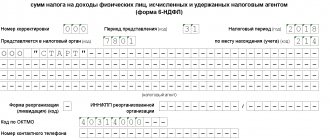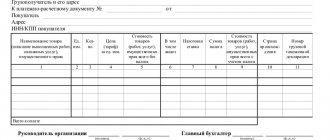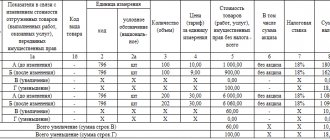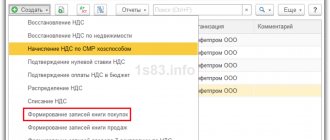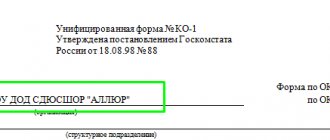The invoice form has a regulated structure, which was approved by government decree No. 1137 dated December 26, 2011 (as amended on August 19, 2017). The form is necessary to organize accounting for both parties to the transaction - buyers and sellers. It confirms several operations at once:
- shipment of the consignment;
- the fact of provision of the ordered services;
- the reality of the work.
With its help, not only the transfer of products to the customer is recorded, but also its valuation. When an invoice is filled out, the sample cannot be changed by the company itself. All adjustments to the form can be carried out only at the legislative level. If the template is incorrectly designed and the data reflected in it is inaccurate, the buyer may face the problem of non-recognition of the claimed VAT deduction.
Concept and legislative regulation
The invoice form is prepared by the seller.
The 2021 Invoice Log displays information about these activities.
If manipulations are subject to tax, then this is also done using books to record purchases/sales.
The invoice form has a standard template; it is written out by the seller and provided to the buyer after receipt (shipment) of the goods and materials.
The invoice sample has no significant changes since January 1, 2021.
Invoice form
The main legal acts on the issue under consideration, approved standard forms and Rules on how to maintain a journal for registering invoices in 2021, as well as reflecting the changes that have appeared:
- Tax Code of the Russian Federation;
- Resolution No. 1137.
A sample invoice in 2021 may change its external form, provided that the order in which the indicators are displayed and their number compared to the standard form are not violated.
In the process of purchase and sale, two parties interact: the seller, who also acts as a contractor or executor obligated to pay VAT, and the buyer/customer.
It is the latter who receives the document after receiving the goods or services performed. The first party also keeps one copy.
Important: An invoice in 2021 is the basis for the client to accept the amounts of value added payments presented by the seller for deduction.
The 2021 invoice sample is a form with a table indicating the list of goods/services, their price, rate and tax amount, as well as excise taxes, digital codes, details of customs documents, inventory codes and their calculation measures.
The invoice form also comes in different types: for advance payments, corrective.
Information about issued and accepted invoices forms the Purchase/Sales Book
back to menu ↑
Online invoice
The use of electronic invoice format can significantly simplify and speed up the document flow between buyer and seller. You can prepare a document online using free services or specialized programs on the Internet.
Current services for online invoice preparation:
- "Service-Online";
- “Everything for an accountant”;
- "BukhSoft.Online".
With these services, to start filling out an invoice, you only need to register your company on the site.
Latest changes and news
Starting from January 1, 2021, the invoice has some improvements in its appearance and in the standards for filling it out (Resolution No. 1137):
- the sample invoice in 2021 is supplemented with a column for the code of the type of goods and materials, which is filled in by organizations supplying them to the EAEU (Eurasian Economic Union);
- the invoice from January 1, 2021 must have the location of the parties entered in the Unified State Register of Legal Entities and the Unified State Register of Individual Entrepreneurs;
- for import, not a serial number is entered, but the registration digital value of customs declarations;
- For the sale of scrap metal in 2021, the invoice is issued in accordance with changes in legislation, since such commercial activities have become taxable. An invoice is created from January 1, 2021 for transactions with them;
- The invoice for 2021, the sample of which has undergone some innovations, has also changed the form of VAT declarations.
back to menu ↑
Application example
Enterprises whose activities include the sale of scrap metal in 2021 must issue an invoice.
These changes in the invoice are due to the fact that the benefits for such transactions have been canceled (Federal Law No. 335 of November 27, 2017).
When scrap metal is sold in 2021, the invoice is issued by the seller, as with regular goods and materials.
Let's consider several nuances of the process of its registration, depending on who pays VAT.
When purchasing scrap from a VAT payer, the client is obliged to perform the functions of a tax agent for this tax and the provisions of the law do not exempt sellers from creating an account. When the specified payment must be made by the tax agent (client), the seller-taxpayer issues an invoice for scrap metal in 2021 from o. This tax on such transactions is not calculated by the seller.
For his part, the acquirer must charge the specified duty (18%) and reflect this in the sales books.
An invoice in 2021 will allow him to deduct this payment when using the general tax regime.
This is why you need an invoice for scrap metal in 2018.
It should be noted that when applying the special regime n/a, the buyer must also calculate VAT on the price of scrap, but in this case it is impossible to apply for a deduction.
If the buyer is an individual, then the seller must decide on the value added payment himself and pay it to the budget.
For him, this will be a transaction subject to the specified tax. After such a sale of scrap metal is carried out in 2021, an invoice is created according to standard rules.
back to menu ↑
Tabular part
- Column 1 of the table contains the name of the product or service being purchased. In the new field 1a the product code is entered.
- Columns 2-9 are filled in by the seller in accordance with the data about the product or service.
- If products of Russian origin are supplied, then columns 10, 10a and 11 are not filled in. If the goods are produced in another country, then fields 10-11 are filled in in full accordance with the customs declaration.
- At the end, the signatures of the manager and chief accountant or their authorized persons are placed. The organization's seal is affixed if available.
Peculiarities
| Parameter | Meaning |
| Who issues it and why? | The invoice for scrap metal in 2021 is issued by the seller. Sales of scrap in 2021 are displayed in invoices according to standard rules, as for ordinary goods and materials. The obligation to pay VAT lies with buyers. But this does not apply to cases when it is purchased from individuals who do not have individual entrepreneur status. The purchaser purchasing from a VAT payer pays the specified payment, regardless of whether he himself has the status of a taxpayer, and he needs an invoice in 2018 in order to reimburse the tax paid. That is, entities on special regimes and exempt from non-taxation must still pay VAT when purchasing goods, but only if they bought from an entity that is a payer of this tax. |
| Example | If the receiver of recyclable materials accepts it from an individual who is not an individual entrepreneur, there is no need to pay VAT to the collection point. Similarly, when a plant buys from non-paying counterparties who, for example, are on the simplified tax system (Simplified Taxation System). |
| Mark if purchased from a defaulter | It is important for the client to have confirmation of what he is purchasing from the defaulter, therefore such an invoice for scrap metal in 2018 contains the indication “Without tax” (paragraph 6, paragraph 8, article 161 of the Tax Code). |
| Peculiarities | The invoice from January 1, 2021 is issued by the seller. When the client is a VAT payer and pays it upon purchase, the seller, if he also has taxpayer status, is obliged to invoice it. This sample invoice in 2021 has the indication “VAT calculated n/a”, since it is the client who makes the payment. The above fully applies to partial payments, then the invoice is issued against future shipments, and the invoice adjustment form is also used. In this case, all numerical values can be changed, but this must be confirmed by primary documents justifying the change in the quantity of goods and materials, prices (for example, confirmation of an increase in the cost of consumables, electricity). |
| Export | During export manipulations, the sale of scrap in 2021 will issue an invoice at zero rates. |
So, let’s summarize and derive the features that the 2021 scrap invoice has:
back to menu ↑
Who is obliged to exhibit?
According to the provisions of Article 143 of the country’s basic fiscal document, organizations, individual entrepreneurs, as well as persons recognized as VAT payers in connection with the movement of goods across the border of the Customs Union are recognized as VAT taxpayers.
They are the ones who are required to present the designated paper. For consumers who are VAT payers, it is this accounting document that serves as the basis for deducting VAT, which is presented to them for payment by the seller when purchasing goods and services from him.
However, everyone should understand that they have the right to apply for a deduction only if the supplier of work or services, who is considered a VAT payer, has formalized it properly. If the prepared and submitted paper contains any defects or inaccuracies, then it will be somewhat difficult to apply for a deduction on it.
When to exhibit and when not to
Let's consider when a document is indispensable and when it is not required:
| Required | Not required |
| The invoice form does not require filling out for transactions without VAT, except for goods and materials sold to the EAEU region. | |
| For all transactions with VAT, including receipt of advance payments on transactions subject to it. | The buyer or customer is not a VAT payer and has a non-invoicing agreement with the seller. |
| In commercial relations with interdependent persons, the seller increases the cost to the market level and adjusts the tax base. |
When goods and materials exempt from taxation are sold, the invoice is issued at the request of the seller.
That is, it is not required, but it is not prohibited to issue it, for example, if the client requires it.
At the same time they put about. The register of invoices in 2021 should be maintained as usual.
back to menu ↑
Issuance procedure
A sample invoice in 2021 is created both on paper and through electronic forms.
The prepared invoice form is handed over or sent to the counterparty during the process of receiving the goods or immediately thereafter.
For this purpose, the law establishes special deadlines and rules.
The invoice form prepared electronically is used when there is mutual agreement and the availability of compatible technical means.
Such invoices must be sent only through certain operators of this type of document flow; their list is on the Federal Tax Service website.
Important : The rules for filling out invoices allow them to be issued simultaneously on paper and electronically. Accounts are drawn up for each primary document, but it is not prohibited to combine transactions for several such documents in one form, indicating the total number of inventory items.
back to menu ↑
Deadlines
The rules for filling out invoices have their own deadlines, limited to a period of 5 days (calendar) from the date of advance payment or acceptance of the completed goods, or shipment of the goods.
The last day in the last two cases is considered to be the time of issuance of the first primary paper.
If the deadline is the same for several such documents, then they can be combined in one form.
| For goods | For services |
| 5 days from the date of | 5 days from the date of |
| Shipment or transfer of rights to an object. | Signing acts confirming acceptance of works/services. |
| Receiving an advance payment (the invoice for advance payment for 2021 has separate rules for filling out) | Receiving an advance |
| The deadlines are counted from the date following the date when the shipment (transfer of rights) or receipt of the advance occurred. | The deadlines are calculated from the day following the day when the act was signed or when the money arrived in the executor’s account. |
This can be done if the relationship between the counterparties is carried out on an ongoing basis (for example, daily sales to the same entity). The sample invoice from January 1, 2021 allows you to issue one general document for all goods and materials sold at the end of the month.
In the case of an account, it is created every month before the 5th day.
An invoice prepared as one form is possible for many transactions, if during the 5-day period after the first transaction several more sales agreements for the same client are drawn up. One account will be issued within the specified period.
When trading retail, if payment is made in cash, the rules for filling out invoices allow you not to indicate VAT in a special line on price tags and other forms.
It is included in the price and the formation of the document in question is not required.
Important : For multiple non-cash transactions, the document can be created in one form at the end of the tax period.
back to menu ↑
Who exhibits
The account is drawn up, as well as the journal for registering invoices in 2018, by the following entities:
- suppliers;
- companies performing construction and installation work for their own needs or when they performed work (services) for intra-organizational needs, the costs of which are not taken into account when calculating income tax;
- tax agents for VAT. That is, companies purchasing inventory and materials from foreign legal entities not registered for tax purposes in the Russian Federation, including tenants of state real estate and buyers of such objects not assigned to state organizations;
- intermediaries on their own behalf, but using the customer’s funds, if such a person applies the general taxation regime;
- forwarders organizing transportation for customers using third party resources, as well as developers or customers performing their functions;
- those involved in organizing construction work for investors by attracting contractors;
- suppliers of goods to the EAEU exempt from VAT.
back to menu ↑
How to fill out
The sample invoice for 2021 contains the following fields to fill out:
At the very end, the sample invoice for 2021 is certified by the signature of management and an accounting specialist; if the latter is not at the enterprise, then only the former.
The completed invoice is affixed with the organization’s seal from January 1, 2018; a sample of it, as before, is issued to the buyer.
The registration details of the enterprise must be indicated.
The rules for filling out invoices must be observed - this is the basis for subsequent accounting actions when calculating VAT.
back to menu ↑
Actual news
08.11.2018
VAT changes: in 2021 and from 2021
From 2021, the basic VAT rate has been increased to 20 percent.
There are no rules for switching to a new rate in the legislation. Therefore, the Federal Tax Service, in agreement with the Ministry of Finance, has issued clarifications for the most important situations. 2021 invoice adjustment
In 2021, when goods were shipped, the seller invoiced the goods at a rate of 18 percent. In 2021, the parties changed the price or quantity of goods. What VAT rate should I indicate on the adjustment invoice?
Indicate in column 7 of the adjustment invoice the VAT rate of 18 percent. It doesn’t matter that you drew up this document in 2021, when the new VAT rate came into effect.
The new VAT rate of 20 percent applies only to goods whose shipment date fell on or after January 1, 2019. The new rate does not apply to shipments in 2021 (Clause 4, Article 5 of Law No. 303-FZ dated August 3, 2018). Apply this rule, including when you create adjustment invoices for 2021 shipment invoices.
Indicate in column 7 of the adjustment invoice the VAT rate that was in effect on the date of shipment of goods in 2021. This is the 18 percent rate that you indicated in box 7 of the original invoice to which the adjustment invoice was drawn up. There is no reason to indicate a new VAT rate of 20 percent (clause 1.2 of the Federal Tax Service letter No. SD-4-3/20667 dated October 23, 2018).
Sellers are required to issue adjustment invoices if the cost of shipped goods, works, services or transferred property rights has changed. A change in value can be caused by an increase or decrease in the price, quantity or volume of supplied valuables (paragraph 3, clause 3, article 168 of the Tax Code). In other cases, adjustment invoices are not necessary.
2021 Invoice Correction
In 2021, when shipping goods, the seller issued an invoice at a VAT rate of 18 percent. In 2021, the parties discovered an error, so a corrected invoice must be drawn up. What VAT rate should I include on the amended invoice?
Indicate in column 7 of the corrected invoice VAT at a rate of 18 percent. It doesn’t matter that you made corrections to the document in 2019, when the new VAT rate came into effect.
The new VAT rate of 20 percent applies only to goods whose shipment date fell on or after January 1, 2019. The new rate does not apply to shipments in 2021. This is stated in paragraph 4 of Article 5 of the Law of August 3, 2018 No. 303-FZ. Apply this rule also when correcting invoices for shipments that were made in 2021.
Enter in column 7 of the corrected invoice the VAT rate that was in effect on the date of shipment in 2021. This is a rate of 18 percent, it is indicated in column 7 of the invoice, to which the corrected invoice was drawn up (clause 1.3 of the Federal Tax Service letter No. SD-4-3/20667 dated October 23, 2018).
When an invoice is corrected (including an adjustment one), the seller issues new corrected invoices. However, in the corrected invoice, you cannot change the information from line 1 of the primary invoice. Instead, on line 1a you need to indicate the serial number and date of correction of the primary invoice. This procedure is provided for in paragraph 7 of Appendix 1 to Government Resolution No. 1137 dated December 26, 2011.
The buyer received the invoice for 2021 in 2019
At what rate should VAT be deducted if the seller shipped the goods at the end of 2021, and the buyer capitalized them and received an invoice in 2021? The time gap is due to the long transportation of goods across Russia.
Deduct input VAT in the amount indicated by the seller in the invoice. It doesn’t matter that you received the documents and received the goods after switching to a new rate.
The seller charged VAT on the date of shipment. That is, in 2021 at the current rate of 18 percent. There are no grounds for charging tax at the new rate in 2021. Therefore, the buyer has the right to deduct VAT at the rate indicated in the 2021 invoice. The dates of receipt of goods and invoices do not matter. The new VAT rate of 20 percent is valid only for goods whose shipment date fell on the period from January 1, 2021 (clause 4 of Article 5 of Law No. 303-FZ dated 03.08.2018, letter of the Ministry of Finance dated 06.08.2018 No. 03-07- 05/55290 and dated 08/01/2018 No. 03-07-11/53970).
Return of goods shipped in 2021
The seller shipped the goods in 2021 and charged VAT at a rate of 18 percent. In 2021, the buyer returned the product. How can a seller process a product return in 2021?
Issue a corrective invoice for the return. Include VAT at a rate of 18 percent. Do this regardless of the reason for the return or whether the item has been accepted for registration. Let's consider each possible situation.
The buyer did not accept the goods for registration.
The seller shipped the goods in 2021, but due to long transportation, the buyer received it only in 2021. Upon acceptance, the buyer discovered a defect, did not accept the goods for accounting and returned it to the seller. In this case, the general rule applies - the seller draws up an adjustment invoice. At the same time, he indicates VAT at the rate that was in effect on the day the goods were shipped to the buyer. The buyer should not draw up an invoice for the return shipment of goods (clause 3 of Article 168, clause 13 of Article 171, clause 10 of Article 172 of the Tax Code, clause 2 of Appendix 2 and clause 12 of Section II of Appendix 4 to the Government Decree dated December 26, 2011 No. 1137). The Federal Tax Service confirmed this procedure in paragraph 1.4 of letter No. SD-4-3/20667 dated October 23, 2018.
The buyer accepted the goods for registration.
For this case, the Federal Tax Service has provided an exception to the general rule. Buyers were allowed not to issue an invoice for the return shipment of goods. Instead, the seller will be able to issue an adjustment invoice. In it, he will indicate VAT at the rate that was in effect on the day the goods were shipped to the buyer. The department plans to establish this procedure as an exception. It can only be used when returning in 2021 goods that were shipped earlier and accepted for registration by the buyer. There will be no exceptions for other cases. Explanations are in paragraph 1.4 of letter No. SD-4-3/20667 dated October 23, 2018.
Let us remind you that, as a general rule, when returning a registered product, the VAT payer buyer must issue an invoice to the seller for the return shipment (letters from the Ministry of Finance dated 03/02/2012 No. 03-07-09/17, dated 02/20/2012 No. 03-07-09/ 08, Federal Tax Service No. AS-4-3/11044 dated 07/05/2012, clause 3 of Section II of Appendix 5 to Government Resolution No. 1137 dated 12/26/2011).
At the same time, for shipments from January 1, 2021, a VAT rate of 20 percent applies (Clause 4, Article 5 of Law No. 303-FZ dated August 3, 2018). If the law is strictly followed, then when returning the goods, the buyer must issue an invoice to the seller and charge VAT at a rate of 20 percent. But it is more logical if the VAT amounts previously accrued by the seller and accepted for deduction by the buyer are compensated upon return. This follows from paragraph 5 of Article 171, paragraph 4 of Article 172 of the Tax Code, subparagraph “a” of paragraph 7 of Section II of Annex 3 to Government Resolution No. 1137 of December 26, 2011. That is why there will be an exception for such situations.
When returning goods, the buyer must restore the VAT previously accepted for deduction. The basis is subparagraph 4 of paragraph 3 of Article 170 of the Tax Code. The tax must be restored using the adjustment invoice issued by the seller (clause 1.4 of the Federal Tax Service letter No. SD-4-3/20667 dated October 23, 2018).
The buyer is a VAT non-payer.
If the goods are returned by a buyer who does not pay VAT, to whom the seller did not issue an invoice, a special procedure applies. In this case, for deduction, the seller registers an adjustment document in the purchase book with summary (summary) data on return transactions for the month or quarter, regardless of the cash register readings. For example, this could be an accounting certificate (clause 1.4 of the Federal Tax Service letter dated October 23, 2018 No. SD-4-3/20667).
Advance payment for rent of state property in 2021
In 2021, the tenant makes an advance payment for the periods of 2019. At what rate should he, as a tax agent, pay VAT on the advance payment for the lease of state property?
On the day of payment of the advance, charge VAT at the rate of 18/118. Pay it to the budget at the end of the quarter. Do not recalculate VAT on government rental services that you will actually receive in 2021.
Tax agents calculate VAT in a special manner - they determine the tax base and withhold it from the recipient’s income on the date of payment. If there was an advance, then the tax agent is not required to determine the tax base a second time after shipment. Therefore, if the date of payment of the advance payment and VAT withholding fell in 2021, there is no reason to recalculate the tax in 2021.
On the payment day, calculate the tax and withhold it from the recipient's income. This rule also applies to advances. Transfer the withheld VAT from the advance payment to the budget as usual - based on the results of the quarter. Tax agents who lease state or municipal property from executive authorities and management bodies pay VAT within the general terms. That is, monthly in equal installments no later than the 25th day of each of the three months that follow this quarter (paragraph 1, paragraph 3, article 161, article 163, paragraph 1, article 174 of the Tax Code). The deadline for paying VAT for the fourth quarter of 2021 is no later than January 25, February 25 and March 25.
It does not matter that the period for which the rent is transferred is the months of 2021. The rule that the 20 percent rate applies to shipments starting from January 1, 2021 does not apply in this case. Explanations are in paragraph 2.1 of the letter of the Federal Tax Service dated October 23, 2018 No. SD-4-3/20667.
Advance to a foreign contractor for services in 2021
In 2021, the Russian organization transfers an advance for services that the foreign contractor will provide in 2021. Services are considered to be realized in Russia. A foreign company is not registered with tax authorities in Russia. At what rate should VAT be withheld by a tax agent who is a customer of services from a foreign organization?
On the day of payment of the advance, charge VAT at the rate of 18/118, withhold it from the recipient’s income and transfer it to the budget. In 2021, when the services are provided, do not recalculate the tax.
Tax agents who purchase goods, works, services or property rights from foreigners charge VAT in a special manner. They determine the tax base and withhold tax on the date the income is paid to the contractor. If there was an advance, then the tax agent does not determine the tax base a second time after the provision of services. Therefore, if the date of payment of the advance payment and VAT withholding fell in 2021, there is no need to recalculate the tax in 2021.
The tax agent - the customer of services or work is obliged to transfer the withheld tax to the budget simultaneously with the payment of money to the foreign counterparty. After this, his obligation to make payments to the budget is considered fulfilled. This procedure is used by tax agents who order services or work, including when making advances. This follows from paragraph 2 of paragraph 4 of Article 174 of the Tax Code.
It does not matter that the period in which the services will be provided is the months of 2019. This situation is not affected by the general rule that the 20 percent rate applies for shipments starting from January 1, 2019. Explanations about this are in paragraph 2.1 of the letter of the Federal Tax Service dated October 23, 2018 No. SD-4-3/20667.
Apply the same rules when purchasing goods and property rights from foreign sellers. It doesn’t matter that in this case agents pay tax in the general manner - based on the results of the quarter.
Payment to a foreign seller for 2021 shipments
In 2021, the Russian organization transfers payment for goods that the foreign seller shipped in 2021. The place of sale of goods is Russia. A foreign company is not registered with tax authorities in Russia. At what rate should a tax agent who purchases goods from a foreign organization withhold VAT?
On the day of payment of the advance, charge VAT at the rate of 18/118, withhold it from the recipient’s income and transfer it to the budget. Do not apply the VAT rate of 20/120 percent.
In this case, please note the general rule that the new VAT rate of 20 percent applies only to goods whose shipment date fell on or after January 1, 2021. The new rate does not apply to shipments in 2018 (Clause 4, Article 5 of Law No. 303-FZ dated August 3, 2018). Therefore, there is no reason to withhold VAT from payment for such shipments at a rate of 20/120 percent.
Apply the estimated rate of 18/118, despite the fact that tax agents who purchase goods from foreigners charge VAT in a special manner. They determine the tax base and withhold tax on the date the income is paid to the seller. In our case, this date falls on 2019. But this is not the deciding factor. More importantly, the shipment was in 2021. Explanations about this are in paragraph 2.1 of the letter of the Federal Tax Service dated October 23, 2018 No. SD-4-3/20667.
Apply the same rules when purchasing services, works, or property rights from foreign sellers. The procedure and timing of payment of withheld VAT do not matter.
Import from the EAEU
The Russian organization imported goods from the EAEU in December 2018, and must pay the tax in January 2021. At what rate should VAT be charged on such imports?
Tax at 18 or 10 percent. In January 2019, transfer the accrued tax amount to the budget. It doesn’t matter that at this point the VAT rate has already increased.
When importing goods from EAEU countries, buyers do not pay VAT at customs. Importers transfer the tax to the budget through the tax office. At the same time, they determine the tax base for VAT on the date when they accepted the imported goods for registration (clause 4 of article 72 of the Treaty on the Eurasian Economic Union, clause 13 and clause 14 of Annex 18 to the Treaty on the Eurasian Economic Union).
VAT must be paid when importing goods from the EAEU countries no later than the 20th day of the next month (clause 19 of Annex 18 to the Treaty on the Eurasian Economic Union). Therefore, the deadline for paying VAT for goods imported in December 2021 is until January 20, 2021. But the fact that the VAT payment deadline for December fell in 2021 is not a reason to recalculate the tax at a rate of 20 percent. The new VAT rate does not apply to goods that a Russian organization imported from the EAEU and accepted for accounting in 2021. The Federal Tax Service is preparing clarifications on this.
The importer has the right to deduct VAT in the amount that he paid to the budget (clause 2 of Article 171 and clause 1 of Article 172 of the Tax Code, clause 26 of Appendix 18 to the Treaty on the Eurasian Economic Union). Therefore, in your December declaration, deduct VAT at the rate that was in 2021. It doesn't matter that you file this return in 2019, when the new rate is in effect.
VAT on government contracts 2021
Is it possible to change the price of a government contract in 2021 due to an increase in the VAT rate?
As a general rule, you cannot change the contract price. Therefore, it turns out that in 2021 the tax will be increased at the expense of the supplier. But there are exceptions in which adjustments are possible.
The price of a state (municipal) contract is determined for the entire period of its execution. It is firm, and the customer has no right to change the terms of the contract. Changing the VAT rate is not the case when you can change the price of a government contract. This is a general rule.
There are exceptions to the general rule. Sometimes the contract price can be adjusted by agreement of the parties, including when the VAT rate changes. For example, the essential terms of the contract can be revised if the price has reached or exceeded the indicators from Government Decree No. 1186 dated December 19, 2013. In these cases, the price can be changed based on the decision of the Government, regional and local authorities. But to do this, it is necessary to justify that execution of the contract without changing its terms is impossible - due to circumstances beyond the control of the parties. This follows from paragraphs 2–4 of part 1 of Article 95 of Law No. 44-FZ. Explanations are in letters from the Ministry of Finance dated August 28, 2018 No. 24-03-07/61247 and the Federal Tax Service dated September 10, 2018 No. SD-4-3/17537.
If there is a decision to change the contract price, record the changes in an additional agreement to this contract. This is a general rule for civil contracts, which also applies to government contracts. This is stated in subparagraph 1 of paragraph 1 of Article 161, paragraph 1 of Article 452, Articles 525–534 of the Civil Code, paragraphs 3, 8 of Article 3 of the Law of 04/05/2013 No. 44-FZ.
VAT on electronic services from 2021
Who must pay VAT on electronic services provided by a foreign organization in Russia? The Russian company transferred payment for 2021 services in 2021.
A foreign organization providing electronic services must transfer VAT to the budget. Since 2019, a Russian customer company is not required to act as a tax agent.
From 2021, the composition of tax agents when providing electronic services by foreign companies has been changed. Russian organizations and entrepreneurs in this situation are no longer required to perform the duties of tax agents. Foreign organizations will independently pay VAT on electronic services provided to any buyer, and not just to citizens (subparagraphs “a”, “b”, paragraph 17, article 2 of Law No. 335-FZ of November 27, 2017). And only in one case will the tax agent transfer the tax. We are talking about an agreement for the provision of electronic services through a foreign intermediary involved in settlements. It is such an intermediary that will act as a tax agent (clause 3 of Article 174.2 of the Tax Code).
The tax base for electronic services of foreign organizations is the cost of services including VAT. It is determined on the last day of the quarter in which the foreign contractor received payment (clause 4 of Article 174.2 of the Tax Code). The tax amount is determined according to the calculated rate (clause 5 of Article 174.2 of the Tax Code).
According to these rules, the procedure for paying transitional VAT depends on the date when the Russian customer of electronic services transferred payment to the foreign contractor. If a foreign contractor received payment for services in 2021, then he himself must fulfill the obligation to pay VAT to the budget. At the same time, the estimated tax rate under paragraph 5 of Article 174.2 of the Tax Code: – previous – 15.25 percent (18/118), if services were provided in electronic form before January 1, 2019; – new – 16.67 percent (20/120), if services are provided electronically starting from January 1, 2021.
If a foreign organization received payment for electronic services in 2021, then the VAT is transferred to the budget by the tax agent - the Russian company. Apply this rule even if the payment relates to services that the foreign contractor will provide starting January 1, 2021. In this case, paragraph 9 of Article 174.2 of the Tax Code applies. It becomes invalid only on January 1, 2021. Explanations are in paragraph 2.2 of the letter of the Federal Tax Service dated October 23, 2018 No. SD-4-3/20667. © Material from the BSS “Glavbukh System”.
How to number
The invoice from January 1, 2021 does not have an officially established number format.
The numbering of invoices is established by the organization itself and is enshrined in its internal documents (by order of the enterprise management).
The main thing is that the details (numbers) have a high degree of uniqueness.
It is recommended to use end-to-end order for them, in ascending order. Numbering of invoices, if done correctly, will eliminate backdating statements.
Composite numbers are used in the following circumstances:
- exhibiting as separate parts of organizations;
- if commerce is carried out by managers under trust agreements or members of a simple partnership.
In other cases, a dividing line can also be used - this will not cause a refusal to deduct - but it is not advisable to do this.
Numbering of advance invoices is carried out for all accounts in the company; if necessary, “AB” is added to the numbers of such forms.
Important : Incorrect numbering of invoices does not entail any liability if this does not prevent the authorized bodies (tax inspectorate) from identifying information when conducting audits. This applies to all errors, not only in numbering, and this is also not a reason for refusing to accept a document for deduction (clause 2 of Article 169 of the Tax Code of the Russian Federation).
Corrections
The seller must make changes to the invoice. This is done by drawing up new s/f - already correct ones.
This also applies to cases where the buyer submitted a clarifying document electronically.
In this case, changes to the field of the original form “Invoice No. ..., from ...” are prohibited.
The field “Correction No...., from...” is filled in with the serial number of the correction and its date.
So, the first copy of the paper account is issued to the client. The second one remains for the seller.
It is generated for each document when selling inventory items subject to VAT.
Its correct formation is a guarantee of tax deduction.
back to menu ↑

